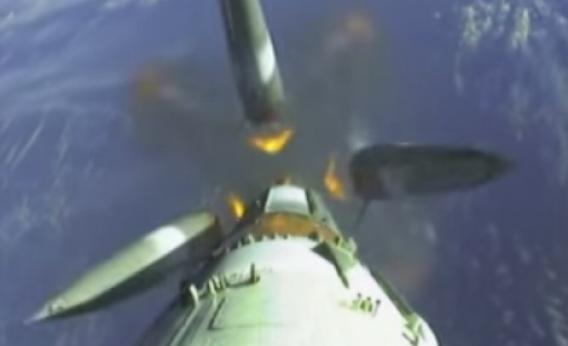Create a free profile to get unlimited access to exclusive videos, sweepstakes, and more!
Ride Along With a Soyuz Rocket Into Orbit

One of the best innovative uses of remote cameras is when space agencies strap them onto the sides of rockets. It’s probably the closest most of us will ever get to seeing what it’s like to hitch a ride into space.
On April 3, 2014, a Soyuz rocket lifted off from French Guiana carrying Sentinel-1A, an Earth-observing satellite (the first in the ambitious Copernicus program, meant to observe our planet’s environment). Two rocket cams were mounted on the side of the upper (Fregat) stage, looking down, and the view they provided was amazing.
There are a few key moments to keep your eyes on:
- 00:58 Main engines start.
- 1:10 Liftoff and rotation to correct attitude.
- 2:09–2:21 Time lapse speeds up (to save time), and you can see the exhaust flame expand as the rocket gains altitude and air pressure drops.
- 2:27: The four external boosters are jettisoned. According to Anatoly Zak of Russian Space Web, this is the first time a Soyuz rocket staging was ever seen in flight. Impressive! I love how their tumbling is synchronized for the first couple of flips.
- 2:47 The fairing protecting the satellite is ejected, and you can see it fall past the rocket.
- 3:17: The second stage separates and the third stage ignites.
- 4:20 Sentinel-1A is ejected into orbit.
We (and by “we” I mean humans) have had some setbacks in the past year with getting rockets launched into space, especially those supporting human exploration. Still, three more people were successfully sent to the space station recently on a Soyuz, which performed well after some recent, ah, issues. SpaceX is planning a return to flight in November after a catastrophic failure in June led to the loss of a Falcon 9 rocket and Dragon capsule with supplies for ISS. Blue Origins is looking toward the future of launches. Boeing is moving along with its manufacturing of the CST-100 capsule, now named Starliner.
If voters can convince Congress to actually fund the Commercial Crew program to its needed level, then in a couple of years we’ll be launching Americans in American rockets from American soil once again, too.
The future of spaceflight can be ours, if we want it. All we really need is to the will to make it so.


























